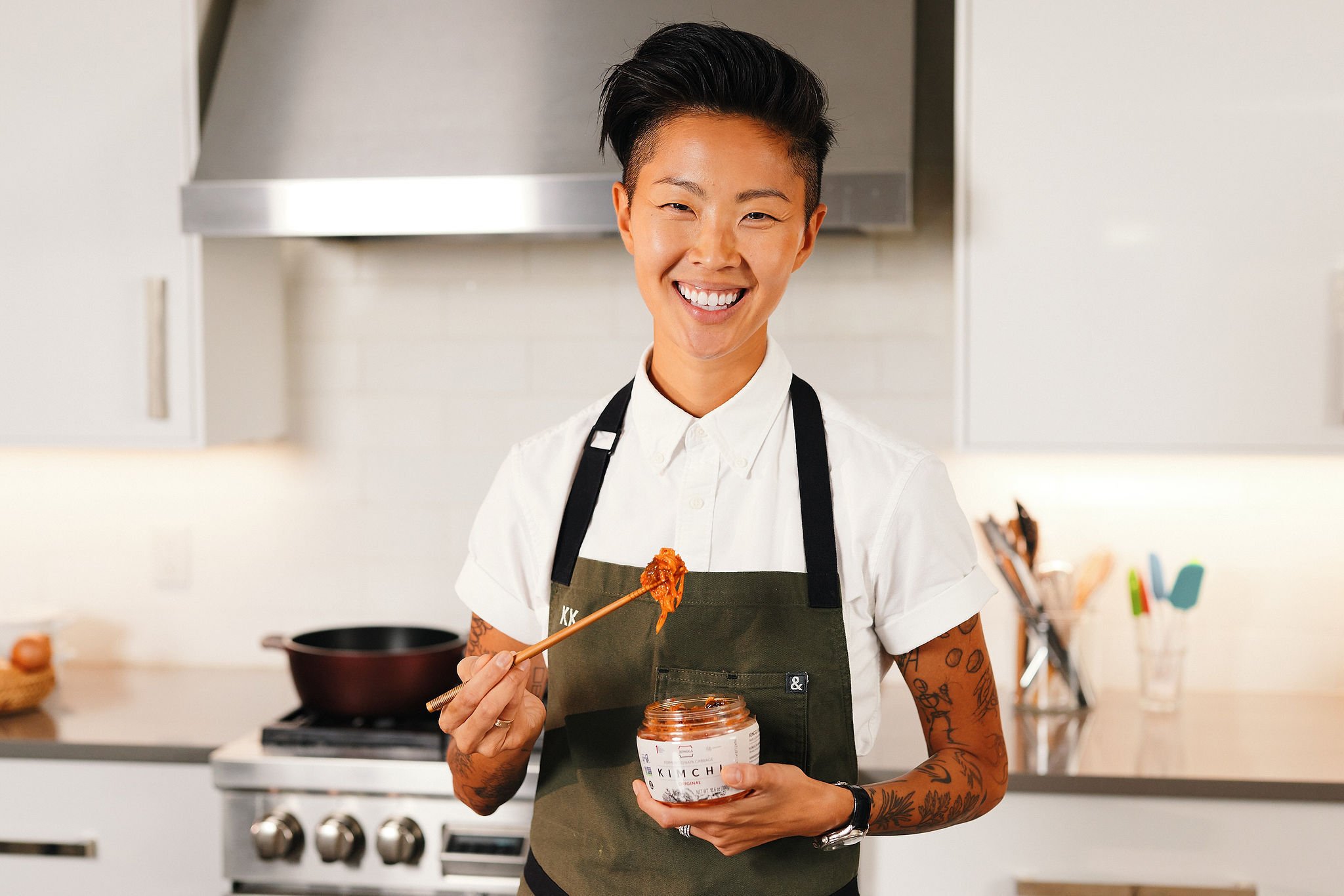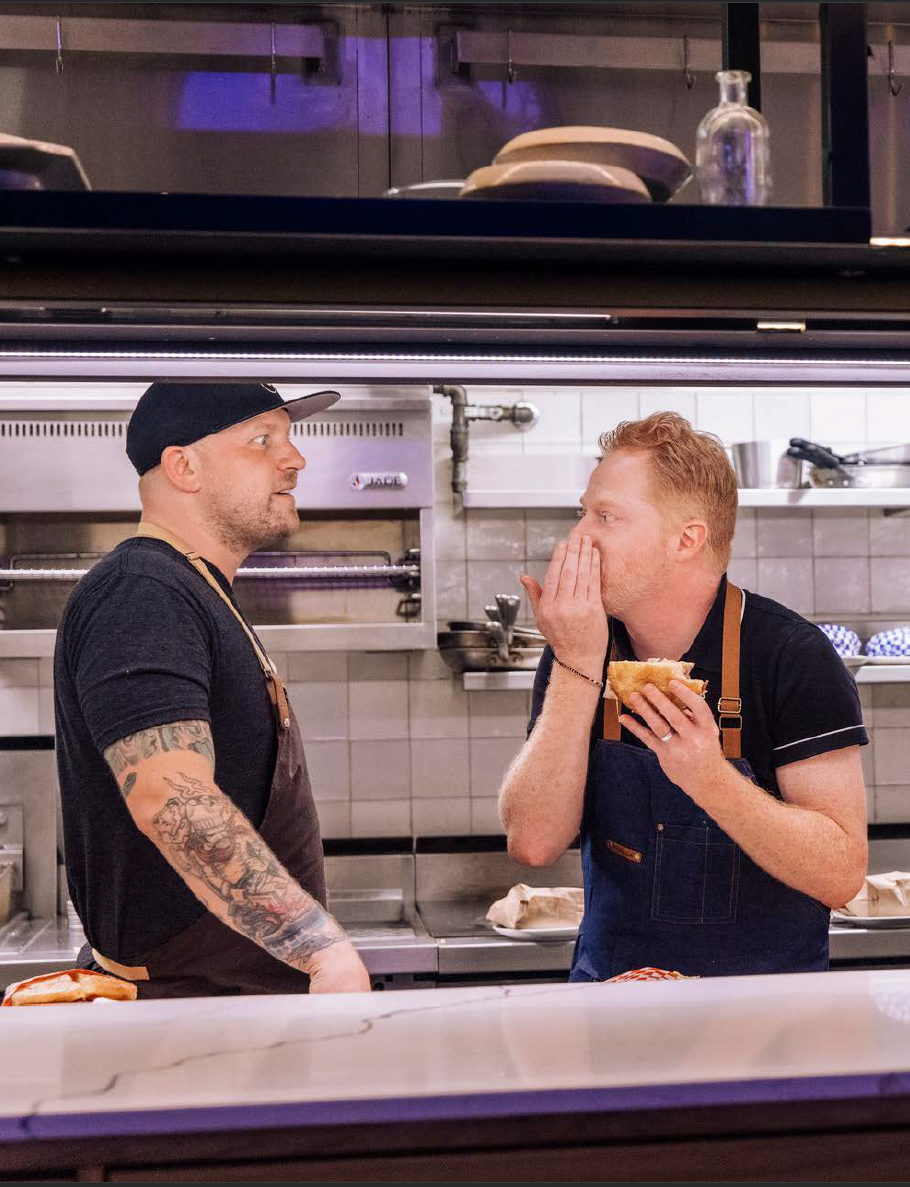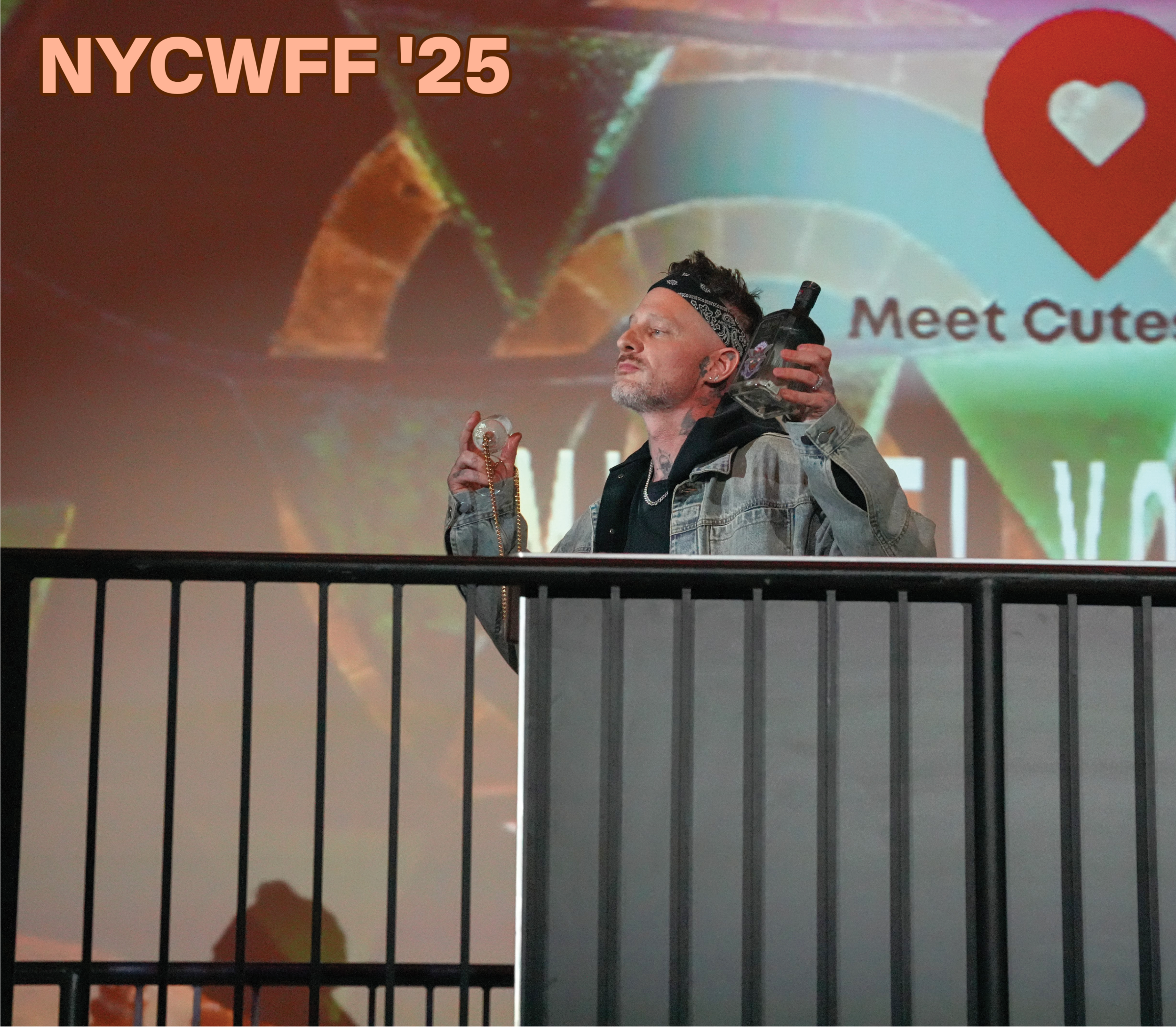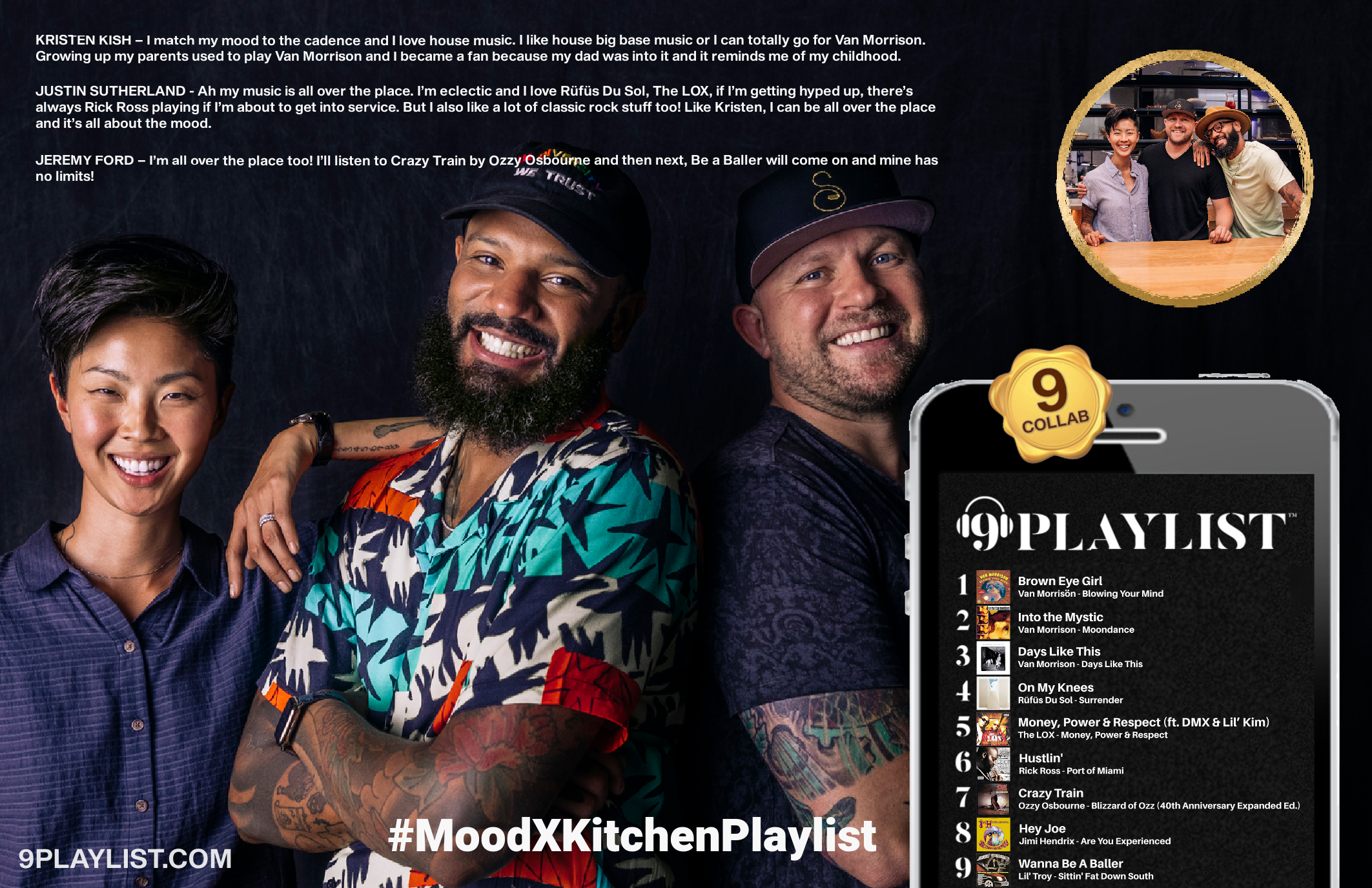We enjoy seeing Kristen Kish hosting, judging a number of culinary shows and taking us through her recent trip to Seoul. We took some time to catch up with her since talking earlier this year ahead of TRU TV's Fast Foodies 2nd season.
We talk about her co-hosting Netflix's Iron Chef: Quest for an Iron Legend, her new show on National Geographic - Restaurants at the End of the World and being on Selena + Chef on HBO Max.
We also talk about her latest partnership with Jongga Kimchi, a worldwide number one Korean brand. She also talked about their Generation Preservation campaign to preserve plant-forward foods, health and wellness through fermentation and environment to minimize food waste.
ATHLEISURE MAG: We enjoyed talking to you earlier this year prior to the 2nd season of Fast Foodies with you and you’re co-hosts Chef Justin Sutherland and Chef Jeremy Ford! It’s great to catch up as you’re always doing great things. We enjoyed seeing you over the summer on Netflix’s Iron Chef: Quest for an Iron Legend! It was great to see the dynamic between you Alton Brown. We love the food fact that we learned about Korean Fried Chicken and how it came to be! Why did you want to be part of this show?
CHEF KRISTEN KISH: I mean, first and foremost, when they say that Iron Chef is coming back and that Iron Chef is coming back on Netflix – it means a lot of different things. Obviously, it’s so iconic in the Japanese form and then to see it evolve over time to hit the Food Network and then for me, Netflix, it just completely diversifies in a lot of different ways. You can hit so many different audiences, you can pull from different chefs and there is just so much more storytelling that can be had.
So I think for me, obviously Iron Chef – yes! Then Iron Chef Netflix and then there’s Alton Brown coming back! So already for me, I was feeling relatively insecure going into that job – it would scare anybody I think to go onto that job and to feel like that I can hold my own and to have enough to say with those things being worth hearing and to being able to do that with the comfort of Alton being next to me. I think that that was a nice dynamic coming together. I mean, all of it scared me shitless, but honestly, how do you not say yes to that?
AM: You looked amazing and you were a perfect fit for it and it was so good to watch. We hope that there will be more episodes of it for future seasons.
CHEF KK: Well thank you, thank you!
AM: You’re also on the latest season of Selena + Chef which is out now on HBO Max. The format of the show is great. How was it for you to do it virtually, to tell someone how to to cook something and what drew you in to want to be part of it?
CHEF KK: Ohh I remember it! So, I requested to my manager that I wanted to go on Selena + Chef! It looked like a lot of fun and I thought, why wouldn’t I want to cook with Selena Gomez? She was like ok and so she does what she does and she was like, great they want you on the next season and I’m like, “perfect!”
Honestly, it was so much more than what I expected in various ways. So I was expecting that I was going to teach Selena how to cook a few things and that we were going to call it a day. But I remember all of the prep-production calls and they were like, “we want to do start to finish. Like we want to have her work, do it – there’s no fluff around it, there’s no swap outs on and off camera.” Everything that she’s doing, we filmed for over a good 6 hours getting this stuff done. Selena went for it! She just did it all! I think that that is just the most interesting thing and it is hard to teach over Zoom because you are missing a human connection in a lot of ways. But for what it was and what was being asked of her to be quite frank, the whole thing was just a really really phenomenal experience.
AM: OMG! You always have so much going on! You’re also hosting Restaurants at the End of the World on National Geographic tell me about this! You’re a traveling girl!
CHEF KK: Oh my goodness! It is! For a girl that didn’t think that she would travel in her life because I thought that I was just going to be working in kitchens and I just wouldn’t make a ton of money – I would just live my life and that was just going to be how it was – to say that I can travel for my job and not only for my job, but in pockets of the world where it’s very foreign to me and meeting chefs that have this resilience in how they run a restaurant and that can be several different definitions. How they can run their restaurants with limited resources and access to the luxuries that we have with our restaurants here especially in the States.
The whole project is really phenomenal. I think that the biggest thing is yes, food is always going to be the through line, but it’s about who these people are and how and why they do this. Like, it’s just mind-blowing to me and I’ve learned a tremendous amount about how to just relinquish control as this is the theme for those people. What will be, will be – and that’s it! Argh that’s such a hard concept because in my form of restaurants, anything that I can control, I’m going to! If I can control the outcome, you better believe that I am going to control the outcome because there are so many unknowns. But all of these people have been really phenomenal.
AM: Can’t wait to check that out as it sounds really exciting.
I love Kimchi, it’s one of my favorite things to eat. You’ve partnered with Jongga Kimchi. Why was this such a fit for you that you wanted to be part of it?
CHEF KK: You know, Korean culture for me, I’ve had a complicated relationship with being an adoptee. I think that a lot of adoptees can relate wherever you are adopted from. Having a connection to your culture when you are brought up in that kind of household or where you are brought up in an environment where people look like you. I think that for me, I always shied away from a lot of it because I thought, I’m not Korean enough. So, who am I to own Korean culture because it’s not mine. But it is mine and I’m allowed to redefine what it is and what it means to me.
So I recently took my first trip to Korea, I ate so much food – traditional and otherwise! For me, I think that it opened up my eyes to say that there’s not just one way to do this. I think that giving myself the permission to lean into partnering with Jongga Kimchi which it originated in Korea, it’s the number 1 world wide brand in Korea! So to say, hold on, they want me for a reason. That reason is because of my story and my interpretation of what being Korean means to me. So I think that just them giving me the permission and them giving me the permission for me to be able to create recipes that aren’t traditionally Korean and I think that that was like this whole moment like, “ahh ok, here we are. Now I understand what this means.” It’s been a really dream partnership for me personally and professionally.
AM: I remember watching your IG when you were going to Korea and it was so cool to see how you were connecting. I think that there is a sense of connection that everyone has even if you grew up in American and you grew up with a family that looks like you and as an African American you’re saying I see this, but where are the roots and what does that mean? I think being able to watch you on your journey and for you to share that with everyone was so impactful and beautiful.
CHEF KK: Thank you!
AM: I enjoy eating kimchi on its own or on a salad. But what recipes in terms of integrating it in a different way? I love this dish so much, what else should we be doing with it?
CHEF KK: Honestly, any place that you can impart acid, I say add kimchi and swap it out! Whether that be a burger or you chop it up and thread it through a beautiful carbonara – think about the little bits of acid and heat through something so rich. I created 2 recipes specifically with Jongga Kimchi.
One is a play off of my Midwestern love for potatoes -
AM: Yes! I live in NY but I’m from Indiana originally!
CHEF KK: Yeah! Ok, then you’re going to be right here with me! I love a tater tot!
AM: Oh yes!
CHEF KK: Give me a tater tot in any form! So now we can jazz it up and we can call it a croquette and now we’re in a little fancier background. Then, the love of Korean BBQ and the cheese corn that you get and then mix it up and putting it all together with this smoked mozzarella bechamel that I make and then thread it with corn, potatoes – thread it, fry it – it’s crunchy, cheesy and delicious.
Then the other one is my ode to little hot dogs wrapped in baked croissant dough! We can’t really call that by it’s brand name because it’s not a croissant, but it’s in dough. The love of pigs in a blanket and it’s just so yummy! And I make a kimchi honey mustard using the kimchi brine because we chop up the kimchi to put it inside of the roll and then we use the brine to make the honey mustard and it’s just so good!
AM: The last time that I talked to you, you turned me onto Kewpie which I loved that! Now you’ve turned me onto the fact that I need my tater tots with kimchi on it – check!
How is kimchi made and why is it so important to preserve plant biodiversity?
CHEF KK: I mean, food waste in general, a lot of times in restaurants, we’re always thinking about how we can preserve and how to make things last. How to use the undesirable pieces of different vegetables and meats. It’s something that I have always been very passionate about ever since I have been in the culinary industry and also learning about how to do it. Because a lot of times, you go to culinary school, but they don’t always teach you how to use the end cuts and how to use the things that are less desirable. So it’s important. I think kimchi is important to preserve the history and the culture of kimchi making! I’ve gone on a deep dive on YouTube watching sweet Korean ladies making kimchi and obviously it stems from a place of need and that’s why we do a lot of things and where it stems from when we do the things that we do. It’s out of necessity. Here’s a fact, there is a very high percentage of cabbage that is at risk or has gone extinct in terms of different varietals that are no longer in use or in production or being grown. So the Generation Preservation campaign that Jongga is doing is really focusing on the preserving of the history of the preservation and why we do the things that we do in order to keep sustaining the vegetables and to kind of keep moving things forward.
So, being able to use products like that is really important and of course how you make kimchi! Now there are various versions. There’s cabbage kimchi, there’s other kimchi’s there’s all this food and food has evolved and carries different stories from all of these different kinds of people. But traditional cabbage kimchi is this rice paste flour, Korean chili flakes, lots of aromatics – ginger, garlic all blended into a paste and then you layer it onto these leaves and I think that a lot of the rich tradition is in the process right? Watching how meticulous it is in order to make it and so I think that anyone at home can make kimchi, do I think that there are far better kimchi’s especially those that I can personally make – absolutely! So sometimes, it’s just best to buy it!
AM: My sister just came back from Seoul and I was watching all of her pictures and I was like, I want to eat it from there!
CHEF KK: I mean, I’ve eaten at a lot of Korean restaurants in LA and in NY and those Koreatowns of those specific cities and you know that you can find some really good stuff. But there is something to be said when you sit in a Korean restaurant with a bunch of Korean people and you don’t understand everything – there’s just something that brings it to a whole other level! I have to tell you that things taste different over there in a really beautiful way!
I will say that when you go, you should try and I don’t know if your sister has gone there – Temple Cuisine. I had a temple lunch in the middle of Seoul and it was just tucked away and the atmosphere was amazing. The food was just transformative in the fact that it is uncomplicated and you just know that it is coming from a place – I don’t even have words to describe it because it’s just a feeling and I highly recommend you hitting that up!
AM: Well, if you say it, that’s all I need to hear!
CHEF KK: It’s really really good!
AM: You’re always on the go and you have so many things going on and I have never been to your restaurant in Austin, Arlo Grey but we have plans to be there next Spring so that we can check it out for ourselves. Are there projects that you’re working on that you’re able to share that we can keep an eye out for?
CHEF KK: Yes! Obviously, we have Restaurants at the End of the World which is coming out and is huge and amazing. And the restaurant – please, please come visit! Parallel to kimchi I have a line of Soju coming out, which is Korean alcohol. I love your reaction, that's a great reaction! A lot of Soju is like ahahah harsh so I’m doing a line of 4 aperitifs with lots of great storytelling and a lot of good stuff and good flavor in it. Keep an eye out for that so grab some Jongga Kimchi and get my new Soju and have a grand old time!
AM: We enjoyed talking with Chef Kristen Kish about her recipes and as we enjoy a great tater tot or croquette, here is how you can make your own with Jongga Kimchi!
JONGGA KIMCHI CREAMED CORN CROQUETTE
PRODUCT | Jongga Napa Cabbage Kimchi
SERVES | 30 - 40 2oz croquettes
PREP TIME | 60 minutes
TOTAL TIME | 1 hour, 30 minutes
INGREDIENTS
FOR THE CROQUETTE
• 2 pounds russet potatoes
• 3 cups of fresh corn kernels (approx. 3 small ears)
• Smoked mozzarella Mornay (see recipe below)
• 2 cups Jongga Kimchi – squeezed dry and finely chopped, reserve 3 tablespoons of Jongga Kimchi juice
• Salt to taste
• Vegetable oil or frying oil as needed
• 1 large Black Truffle as desired/needed
• Celery leaves, lemon, Maldon Salt and chives to garnish
FOR THE SMOKED MOZZARELLA MORNAY
• 3 tablespoons unsalted butter
• 3 tablespoons all purpose flour
• 3 sprigs thyme
• 2 large cloves garlic – peeled and gently smashed
• 1 teaspoon whole black peppercorns
• 1 small shallot – peeled and small diced
• 1¼ cup whole milk
• 1 teaspoon kosher salt
• 6 ounces smoked mozzarella – cut into small cubes/pieces small cubes/pieces
BREADING STATION
• 2 - 4 cups panko – crushed with your hands and mixed with ½ teaspoon kosher salt
• 4 eggs – beaten and mixed with ½ teaspoon kosher salt
• 1 cup all-purpose flour, mixed with 1 teaspoon gochutgaru, ½ teaspoon dried thyme and ½ teaspoon kosher salt
INSTRUCTIONS
FOR THE SMOKED MOZZARELLA MORNAY
1. In a medium saucepan add the butter, flour, thyme, garlic, peppercorns, and shallot.
2. Turn on heat to medium and allow the butter and flour to come together, forming a blond roux.
3. Slowly whisk in the whole milk and allow mixture to come to a simmer, scraping down the sides and stirring frequently. Mixture will thicken.
4. Add in the cheese 1/3 at a time, stirring to incorporate.
5. Once cheese is fully melted, turn off heat and transfer into a wide shallow container, placing plastic wrap directly over the sauce.
6. Refrigerate until the sauce is room temp or chilled to the touch.
FOR THE CROQUETTE
1. Bake potatoes at 400°F for about an hour or until tender.
2. Remove from oven and let cool enough to handle.
3. Remove the skin and gently fork mash the potatoes while still hot, set aside to cool.
4. Mix together the room temperature or cooled cheese sauce with the corn kernels.
5. Add the kimchi, potatoes, and kimchi juice.
6. Mix until incorporated and season with salt to taste.
7. Form into 2 oz discs, larger or smaller depending on preference.
8. Freeze until firm (optional but makes it easier)
9. Working in batches, dredge each croquette in the flour mixture (be sure to tap off excess before moving on) then in the egg mixture, then in the panko mixture.
10. Deep fry in 350 – 370°F vegetable oil.
11. Garnish with celery leaves tossed in lemon juice, chives, Maldon Salt and lots of shaved black truffles.
12. Serve immediately.
PHOTOGRAPHY COURTESY | Kristen Kish
Read the OCT ISSUE #83 of Athleisure Mag and see EXPLORATION THROUGH FOOD | Kristen Kish in mag.















































